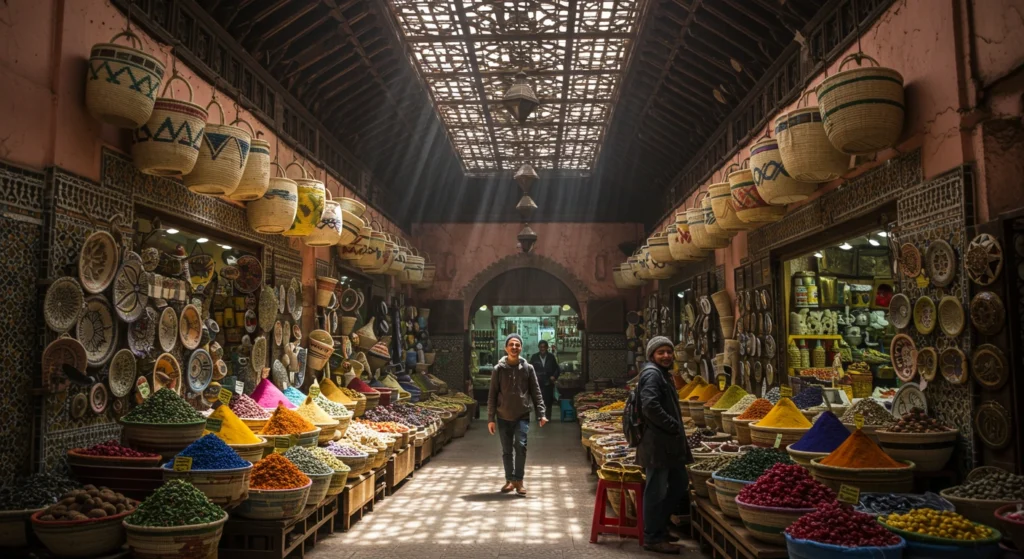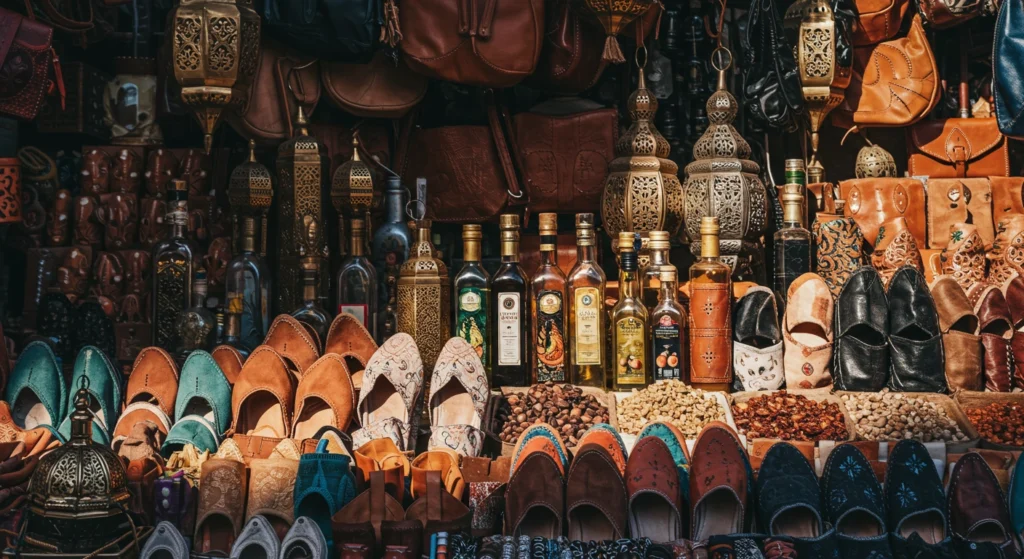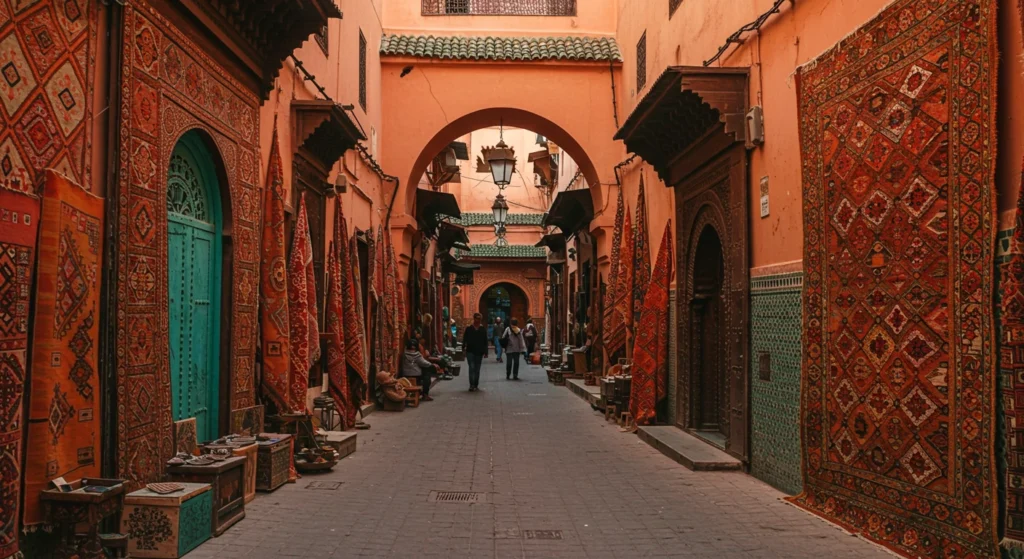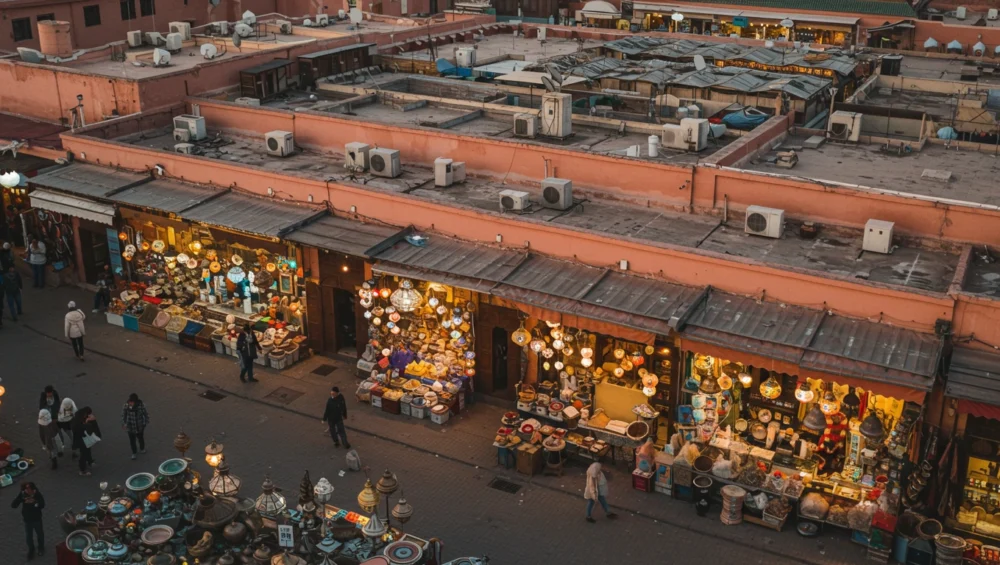The Magic of a Moroccan Souk Experience: Imagine walking into a maze of narrow alleys, where the air is perfumed with exotic spices, the walls shimmer with handwoven rugs, and every corner hides a new surprise. That’s the Moroccan souk experience in Marrakech. It’s not just a market; it’s an invitation to immerse yourself in centuries-old culture and craftsmanship. If you’re planning a trip to Morocco, especially Marrakech, the souks will likely be a major part of your journey. This guide will help you navigate them confidently, understand what to buy, and avoid common tourist pitfalls.
What is a Moroccan Souk? A Cultural and Historical Overview
Souk Definition and Origins
The term “souk” simply means market in Arabic. But in Morocco, it’s far more than a place to shop. These bustling marketplaces have been the economic heart of cities for centuries. Marrakech, in particular, is famous for its sprawling souks that spill out from the main square, Jemaa el-Fnaa, a UNESCO World Heritage site.
Layout and Structure of Marrakech Souks
Souks in Marrakech are categorized by the type of goods sold. You’ll find entire streets dedicated to leather, spices, metalwork, and textiles. The layout is dense and maze-like, making it easy to get lost. But that’s part of the charm—each turn reveals something new.
- Souk Semmarine: A main artery with everything from slippers to lanterns.
- Souk Ableuh: Known for olives and preserved goods.
- Souk Haddadine: Where you’ll find blacksmiths and metal artisans.
Moroccan Souk Shopping Tips for First-Timers

How to Haggle Like a Local
Bargaining is part of the culture here. Vendors expect it, and you should too. Here are some quick tips:
- Start by offering half the asking price.
- Be friendly, not aggressive.
- Walk away if the price is too high—you might be called back with a better offer.
- Use basic Arabic like “Salam Alaikum” (hello) or “Shukran” (thank you) to build rapport.
Best Time to Visit the Souk
- Morning: Less crowded, easier to interact with vendors.
- Evening: Livelier atmosphere, cooler weather.
- Avoid midday: It gets hot and very busy.
Staying Safe and Aware in the Medina
- Keep your wallet and phone secure.
- Be cautious of “guides” who approach you.
- Don’t follow strangers into side alleys.
What to Buy in a Moroccan Souk: Authentic Treasures

Moroccan Spices and Seasonings
You can’t visit Morocco without falling in love with its spices. Whether it’s the floral aroma of saffron or the deep smokiness of paprika, these are souvenirs that keep on giving.
Top Spices to Buy:
- Ras el Hanout: A mix of 20+ spices.
- Cumin: Earthy and essential to Moroccan cooking.
- Harissa: A hot chili paste.
- Turmeric & Ginger: Common in tagine recipes.
Moroccan Spice Mix Recipe
| Ingredient | Quantity |
| Cumin | 2 tsp |
| Ground Ginger | 2 tsp |
| Turmeric | 2 tsp |
| Black Pepper | 1 tsp |
| Cinnamon | 1 tsp |
| Coriander | 1 tsp |
| Cayenne Pepper | 1/2 tsp |
| Nutmeg | 1/4 tsp |
Tip: Make sure spices are fresh. Ask the vendor if you can smell or taste them.

Handwoven Moroccan Rugs (Berber Carpets)
These are masterpieces of tribal art. Each region has its own style, from the minimalist Beni Ourain to the colorful Boujaad.
- Look for hand-knotted vs machine-made.
- Ask about the origin of the rug.
- Most vendors will offer international shipping.
Moroccan Argan Oil and Natural Cosmetics
Morocco is the only place where argan trees naturally grow. You can find both cosmetic and culinary versions in the souk.
- Cosmetic Uses: Hair oil, face moisturizer, anti-aging serum.
- Other Products: Black soap, rhassoul clay, rose water.
Warning: If the price is too low, it’s probably fake.
Leather Goods from the Tanneries
Visit the Bab Debbagh tanneries to see leather being dyed the traditional way. Then shop for:
- Slippers (Babouches)
- Leather poufs
- Handbags & belts
Traditional Moroccan Ceramics and Pottery
From intricately painted bowls to tagine pots, Moroccan ceramics are both functional and beautiful.
- Ask about lead-free glazes if you plan to use them for food.
- Wrap items securely or ask vendors to ship them.
Jewelry, Lanterns & Metalwork
The souks are a treasure trove of handcrafted jewelry and brass lanterns.
- Berber Jewelry: Heavy, symbolic, and often made of silver.
- Lanterns: Pierced metal that casts stunning shadows.
- Copper trays & kettles: Great for traditional Moroccan tea service.
Moroccan Clothing and Textiles
- Kaftans & Djellabas: Traditional Moroccan robes.
- Scarves & Pashminas: Lightweight and versatile.
- Custom tailoring: Available in many textile shops.
Where to Shop: Best Souks by Category
| Item | Best Souk/Area |
| Spices | Rahba Kedima |
| Leather goods | Souk Smata |
| Carpets & Rugs | Souk Zrabia |
| Jewelry | Souk des Bijoutiers |
| Ceramics | Souk El Attarine |
| Argan Oil & Cosmetics | Herbalists near Mellah |
| Textiles & Fashion | Souk Haddadine |
How to Tell What’s Authentic
- Spices: Should be aromatic and vibrant.
- Rugs: Ask for a back view; handwoven ones have knots.
- Argan Oil: Should be in dark glass bottles with a nutty aroma.
- Jewelry: Real silver will be heavier and often marked “925.”

Packing and Shipping Your Souk Treasures
How to Safely Pack Fragile Items
- Use clothes or scarves as padding.
- Buy bubble wrap from local shops if needed.
Shipping Larger Souvenirs
- Many vendors partner with DHL or FedEx.
- Always ask for a tracking number.
- Ensure items are insured during transit.
Final Tips for Making the Most of Your Souk Adventure
- Take your time. Don’t rush the experience.
- Interact with vendors and learn their stories.
- Always carry small change.
- Dress modestly to show respect.
- Bring an empty suitcase or duffel bag—you’ll need it!
Frequently Asked Questions (FAQ) About Moroccan Souk Shopping
What are the best things to buy in a Moroccan souk?
Spices, argan oil, leather goods, rugs, ceramics, and jewelry top the list.
Are Moroccan souks expensive?
They can be, especially if you don’t bargain. Haggle smartly and you’ll get good deals.
How do I spot authentic Moroccan products?
Ask questions, look for handmade details, and trust your instincts. If it feels mass-produced, it probably is.
Can I use a credit card in the souk?
Some larger shops accept cards, but most prefer cash. Always carry Moroccan dirhams.
Is it safe to shop alone?
Yes, but stay alert, especially in crowded areas. Politely decline offers from unofficial guides.
Conclusion: Take a Piece of Morocco Home With You
Wandering through a Moroccan souk isn’t just about filling your suitcase—it’s about connecting with the soul of Marrakech. Each spice, rug, and trinket holds a story, waiting for you to take it home. So breathe in the scents, embrace the art of haggling, and treasure the moments. Your Moroccan adventure starts here.
Ready to get lost in the magic of Marrakech? Share this guide with fellow travelers, and start planning your souk adventure today. If you’ve already explored the souks, drop your favorite find in the comments below!





